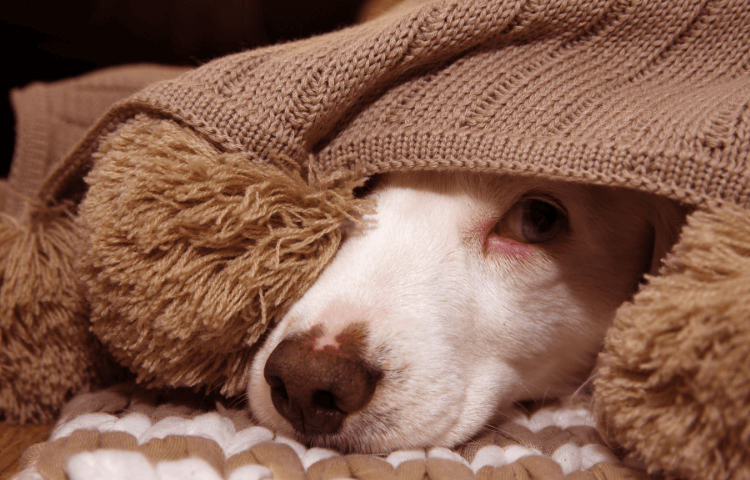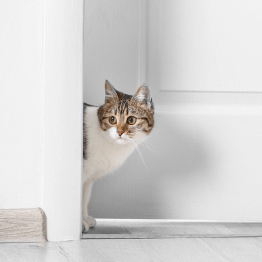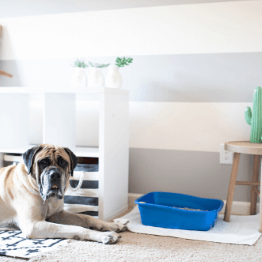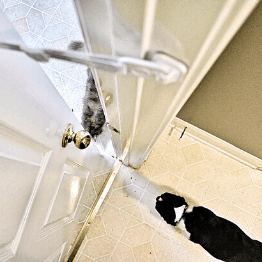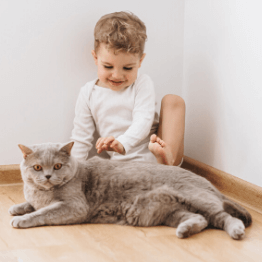HOW TO DEAL WITH DOG SEPARATION ANXIETY
By: Door Buddy Editors | Published: 10 October 2024
If you have a nervous dog, you’re likely familiar with the havoc caused by separation anxiety. Learning how to deal with dog separation anxiety is essential, as it’s a common issue that can lead to chaos if not managed properly.
As much as we love our pooches, having them howl while we’re gone, destroy belongings in our absence, or make a nuisance of themselves isn’t ideal.
Unfortunately, anxiety in dogs is often mistaken for disobedience when, in reality, these behaviors are common signs of nervousness. Learning to recognize the signs and knowing how to calm your dog when you’re away can make for a happier, more relaxed household - and you might just save a good pair of shoes in the process!
WHAT IS DOG SEPARATION ANXIETY
Dog separation anxiety is when your furry friend gets seriously stressed out when you’re not around. Instead of enjoying a nap or some alone time, they might turn into a little ball of nerves, barking nonstop, chewing up your favorite shoes, or even having accidents in the house. For some dogs, the sight of you grabbing your keys or heading toward the door is enough to trigger a full-on panic! While it can be tough to deal with, it’s important to remember that they’re not being naughty - they’re just feeling anxious. With a little patience and training, you can help them relax and feel more comfortable when you’re away, so everyone’s happier!
WHAT CAUSES DOG SEPARATION ANXIETY
-
Change in Routine: If your dog is used to having you around 24/7 and suddenly you’re gone for longer stretches, they might start feeling a bit lonely.
-
New Environment: Moving to a new home or even just rearranging furniture can throw some dogs off and make them anxious when you’re not around.
-
Past Trauma: Pups who’ve been through tough times, like being rehomed or abandoned, are more likely to worry about being left alone.
-
Loss of a Companion: Losing a buddy, whether it’s another pet or a person, can leave your dog feeling insecure and anxious.
-
Lack of Training: If your dog hasn’t learned that it’s okay to be alone, they might get nervous when they see you head for the door.
With a little love and patience, you can help your dog feel safe and sound, even when you’re away!
UNDERSTANDING ANXIETY IN DOGS
The first step in keeping your dog calm when you leave the house is to understand why they feel this way in the first place. Naturally, dogs are pack animals. As his family, you are his pack. Just as dogs are man’s best friends, we are theirs too! When we leave our doggos by themselves, we separate the pack, which may make them scared and a bit lost.
Think of it as going to a party all by yourself without knowing anyone - you tend to be a bit on edge and feel out of place, right? Well, the same thing happens to your dog. As a result, they’re not their usual bouncy and happy selves, where loud noises can frighten them and spark a series of destructive behavior.
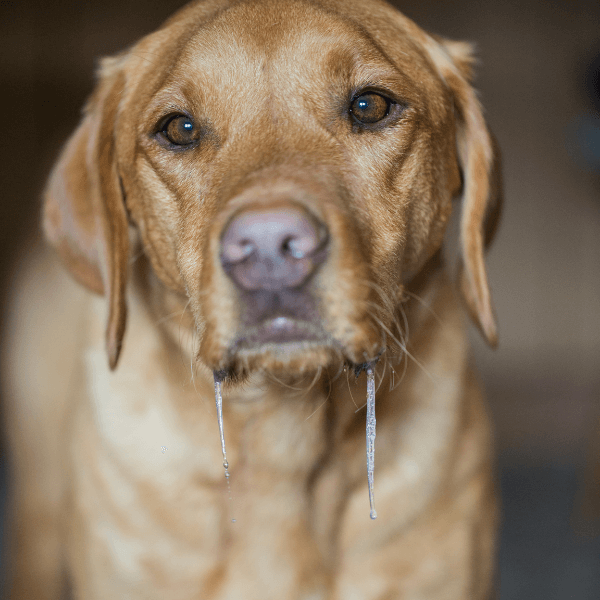
SIGNS OF DOG SEPARATION ANXIETY
Remember, dogs can’t tell us what’s wrong, but they can show us. If you think your pal is suffering from dog separation anxiety, keep your eyes out for these symptoms.
-
Constant howling, barking, or whining
-
Destructive behavior (chewing furniture, shoes, etc)
-
Indoor accidents, even though your doggo is housetrained
-
Heavy drooling or panting
-
Obsessive pacing or restlessness
-
Trying to escape
WHAT CAN YOU DO IF YOU HAVE A NERVOUS DOG?
Although vets may recommend medication as an effective way to keep your dog calm, there are a few things you can do at home. If your nervous dog becomes too much to handle, it’s best to consult a behavior specialist or your vet.
Steps To Help Manage Dog Anxiety
Training a dog with separation anxiety requires patience and a step-by-step approach to help your dog feel more comfortable when left alone. Here’s a guide to get you started:
1. Create A Safe Space
As much as we’d love to spend all day cuddling with our 4-legged friends, there will come a time when we need to leave them alone. To prevent any menacing chewing or barking, try finding a room where your dog feels most comfortable. Ideally, this space should be away from noisy streets to keep sound scares to a minimum. For some dogs, using a dog separation anxiety crate that’s the perfect size can also help them feel more secure. Whether you choose a room or a crate, make sure your pup is happy in the space. You can even add a favorite toy or an item of clothing that smells like you to help your dog soothe themselves when they’re feeling nervous.

2. Gradual Desensitization
Like most dog training tips, success doesn’t happen overnight. If your pet gets nervous when you head out, start by leaving for just a few minutes and gradually stretch that time out. You could run a quick errand or take a short walk around the block. The idea is to help them realize that when you leave, it’s no big deal - and you’ll always come back! As your pup gets used to these mini departures, you can slowly increase the time you’re away. Over time, this helps them feel more confident and relaxed on their own. Toss in a treat or a favorite toy before you leave, and they might even start looking forward to your short absences!
3. Change Up Your Routine
Like “hoomans”, doggos are creatures of habit and can get anxious when their surroundings change. A great tip for managing dog separation anxiety is to create an environment where change feels normal. To do this, make small adjustments at home, like using a different door or putting your belongings in new spots. You can also try feeding them in new areas to help shake up their routine and get used to new experiences.
4. Encourage Exercise
Exercise is a great way to help manage your furry friend’s behavior. Making sure your dog gets a good walk before you leave the house helps burn off extra energy and does wonders for their mental health too.

5. Try Calming Aids
There are lots of calming aids that can help your dog feel more at ease! Pheromone diffusers mimic natural calming signals, while dog-friendly CBD can help reduce anxiety. Anxiety wraps, like ThunderWorksThunderShirts for dogs, give your pup a gentle, comforting hug, and calming supplements can ease stress even further. With these tools, you can find the perfect combo to help your dog feel secure and relaxed, even during tough times. It’s all about helping them chill in a way that works best for them!
6. Use Positive Reinforcement
Rewarding calm behavior is a great way to encourage your dog to stay relaxed. Whenever your dog is chilled out and not acting anxious, give them a treat, offer plenty of praise, or hand over their favorite toy. This helps them associate being calm with something positive and enjoyable. Over time, they’ll start to realize that staying relaxed brings rewards, whether it’s your attention, a tasty snack, or playtime. The key is consistency—reinforcing their good behavior regularly will help them understand.
7. Consult A Vet Or A Behaviorist
If your pup’s anxiety is really intense or doesn’t improve, it’s a good idea to chat with your vet or a dog behaviorist. They can give you personalized tips to help calm your furry friend and might suggest medication for dog separation anxiety if it’s needed. It’s all about finding the right support to keep your dog feeling happy and relaxed!
CONCLUSION: HOW TO DEAL WITH DOG SEPARATION ANXIETY
As frustrating as dog separation anxiety may be, a nervous dog can’t help the way they feel. Learning how to deal with dog separation anxiety takes patience and time. At the end of the day, you are your dog’s sense of safety, and they can feel lost without you. The more you work with your dog to create healthy coping mechanisms, the more comfortable they’ll become when you leave home.
If you’re also a cat owner, you might find it helpful to understand how anxiety affects our feline friends. Check out our blog on 5 Things That Make My Cat Anxious to learn more!

